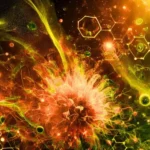In the captivating world of nanoscience, nanoscale chemistry is a discipline that explores molecules’ behavior, interactions, and reactions at the nanometer scale. As we venture into molecular dimensions, it reveals a fascinating landscape where traditional chemical principles take on new significance. This article delves into nanoscale chemistry, unraveling its principles, techniques, and profound implications for advancing our understanding of matter at the smallest scales.
Probing the Nanoscale World of Chemistry
Nanoscale chemistry concerns phenomena occurring at dimensions typically ranging from 1 to 100 nanometers. At this scale, the properties of materials can differ significantly from their macroscopic counterparts, leading to unique and often unexpected behaviors. Understanding nanoscale chemistry requires tools and concepts beyond classical chemistry, embracing the principles of quantum mechanics and surface science.
Quantum Effects and Nanoscale Behavior
At the nanoscale, quantum effects become increasingly pronounced, influencing materials’ electronic structure, optical properties, and reactivity. Quantum dots, for instance, exhibit size-dependent electronic properties due to quantum confinement, offering tunable colors in applications such as displays and imaging. It explores how these quantum effects govern the behavior of matter and opens avenues for tailoring materials with specific properties.
Surface Chemistry and Catalysis
Surfaces play a crucial role in nanoscale chemistry, as a significant proportion of atoms are located at or near the surface of nanomaterials. Surface chemistry becomes paramount, influencing reactivity, adsorption, and catalytic processes. Nanocatalysts, with their high surface area and enhanced reactivity, showcase the transformative impact of nanoscale chemistry in improving the efficiency of chemical reactions for applications in energy, environmental remediation, and industrial processes.
Techniques in Nanoscale Chemistry
Studying nanoscale chemistry requires advanced techniques that can probe and manipulate materials at the molecular level:
Scanning Probe Microscopy
Scanning probe microscopy techniques, such as atomic force microscopy (AFM) and scanning tunneling microscopy (STM), enable the visualization and manipulation of individual atoms and molecules. These tools provide insights into surface structures, molecular interactions, and reaction dynamics at the nanoscale.
Spectroscopy Techniques
Various spectroscopy techniques, including infrared spectroscopy, Raman spectroscopy, and X-ray photoelectron spectroscopy, offer detailed information about nanomaterials’ chemical composition, bonding, and electronic properties. Spectroscopic analyses help unravel the intricacies of nanoscale chemical reactions and structural changes.
Nanoparticle Synthesis and Characterization
Chemists use innovative methods to synthesize nanoparticles with precisely controlled sizes and shapes. Techniques such as sol-gel synthesis, chemical vapor deposition, and green synthesis approaches yield nanomaterials with tailored properties. Characterization methods, such as transmission electron microscopy (TEM) and dynamic light scattering, verify nanoparticle size, morphology, and stability.
Applications of Nanoscale Chemistry
Nanoscale chemistry has far-reaching implications across diverse scientific and technological domains:
Nanomedicine and Drug Delivery
In nanomedicine, it contributes to developing targeted drug delivery systems. Nano-sized carriers, such as liposomes and nanoparticles, enhance drug solubility, improve bioavailability, and enable targeted delivery to specific cells or tissues, minimizing side effects and maximizing therapeutic efficacy.
Nanoelectronics and Materials Science
Nanoscale chemistry plays a pivotal role in designing and fabricating electronic devices and advanced materials. Quantum dots, nanowires, and nanotubes exhibit unique electronic properties that can be harnessed for electronics, sensors, and energy storage applications.
Environmental and Energy Applications
In environmental science, nanomaterials contribute to pollution remediation and energy conversion. They are employed in catalytic converters, water purification, and solar cells, showcasing their potential to address global energy sustainability and environmental protection challenges.
Challenges and Future Prospects
Despite its transformative potential, nanoscale chemistry faces challenges that require innovative solutions:
Toxicity and Environmental Impact
Certain nanomaterials’ potential toxicity and environmental impact are areas of concern. Understanding the long-term effects of nanomaterials on ecosystems and human health is essential for the responsible development and application of nanoscale chemistry.
Standardization and Regulation
The diverse nature of nanomaterials poses challenges in standardizing their characterization and ensuring regulatory frameworks for their safe use. Establishing guidelines for synthesizing, handling, and disposing of nanomaterials is crucial to address ethical and safety considerations.
Integration with Other Disciplines
Advancing nanoscale chemistry requires interdisciplinary collaboration among chemists, physicists, engineers, and biologists. Integration with other scientific disciplines will foster holistic approaches to solving complex challenges and realizing nanoscale chemistry’s full potential.
Conclusion
Nanoscale chemistry opens a window into the intricate world of molecular interactions, quantum effects, and unique behaviors that emerge at the nanoscale. As scientists continue pushing the boundaries of our understanding and technological capabilities, they promise transformative breakthroughs with profound implications for medicine, electronics, environmental science, and beyond. Embracing the challenges and opportunities of nanoscale chemistry will unlock new frontiers in scientific discovery and innovation, shaping a future where manipulating matter at the molecular level becomes a cornerstone of progress.












